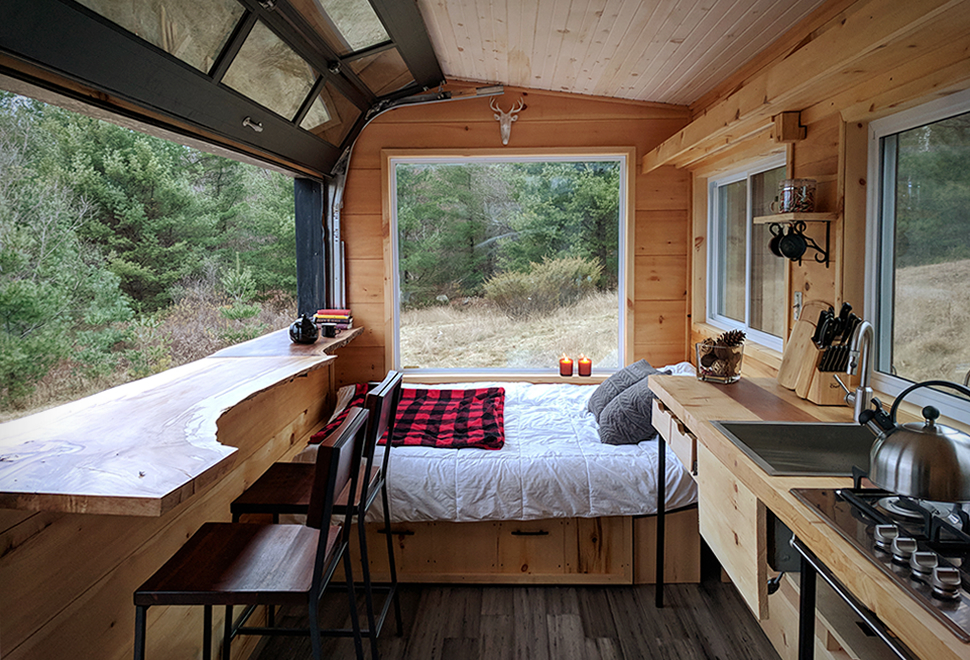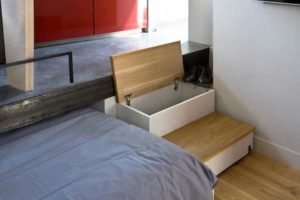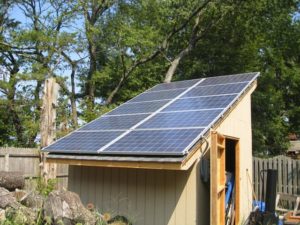The dream of living large in a small space has captivated many individuals looking to escape the constraints of traditional homeownership and embrace a more sustainable lifestyle.
For those who choose to live off the grid, tiny houses offer an appealing solution: they are compact, efficient, and self-sufficient, allowing residents to produce their own food, collect rainwater, and harness renewable energy sources like solar and wind power.
But living in a tiny house presents unique challenges, from navigating tight spaces to managing resources and waste.
We’ll explore the strategies and techniques for living large in a small space while maintaining an off-grid lifestyle.
Embrace minimalism
Living in a tiny house requires embracing minimalism and letting go of material possessions that you don’t need or use. This will not only help you fit more comfortably in your small space, but it will also reduce your environmental impact and save you money.
By doing so, you’ll not only optimize your use of space, but also lessen your environmental impact and save money.
Say goodbye to unnecessary clutter and the financial burdens it brings.
Embrace the freedom of living simply and intentionally.
In a tiny house, every item you keep must earn its keep, so carefully consider each piece of furniture, decoration, and tool you bring into your home.
Keep only what adds value to your life, and find creative solutions for storing and organizing your belongings.
By adopting a minimalist mindset, you’ll be able to make the most of your tiny house and live a more sustainable, financially secure life.
Optimize your space
Think creatively about how to use your space efficiently. Consider the height of your furniture, the layout of your rooms, and the use of multi-functional pieces like Murphy beds, desks that fold out into tables, and chairs with storage compartments.
When it comes to maximizing the efficiency of your space, think beyond the traditional furniture arrangement.
Consider the height of your furniture, as taller pieces can make a room feel more spacious.
For example, opt for tall bookshelves or storage units instead of low-lying ones.
Consider the layout of your rooms, and look for ways to create functional flow.
For instance, place your desk near a window to maximize natural light, and use multi-functional pieces like Murphy beds, desks that fold out into tables, and chairs with storage compartments to serve multiple purposes.
By thinking creatively and leveraging these strategies, you can make the most of your space and achieve a more functional and comfortable living environment.
Invest in high-quality, compact appliances
Choose appliances that are compact in size but high in quality. This will ensure that your tiny house is well-equipped and comfortable, while also saving space and energy. Examples might include a small induction cooktop, a portable washing machine, and a propane-powered refrigerator.
When it comes to outfitting your tiny house with appliances, it’s important to prioritize compact size and high quality.
By choosing appliances that are both small in size and high in performance, you’ll be able to create a comfortable and well-equipped living space without sacrificing precious square footage or energy efficiency.
One great option is a small induction cooktop, which can easily fit on a countertop and uses less energy than traditional electric or gas stovetops.
This means you can prepare delicious meals while saving money on your utility bills.
A portable washing machine can be easily tucked away in a corner of your tiny house, allowing you to do laundry without taking up valuable space.
A propane-powered refrigerator is a smart choice for your tiny house, as it can be easily installed in a compact space and operates more efficiently than traditional electric refrigerators.
Plus, propane is a more energy-efficient choice than electricity, which can help reduce your overall energy usage and save you money.
By choosing appliances that are compact in size but high in quality, you’ll be able to create a comfortable and functional living space in your tiny house, all while conserving energy and saving money on your utility bills.
Harness natural light
Incorporate large windows and skylights into your tiny house design to harness natural light and reduce the need for electricity. This will not only save you money on energy bills but also create a brighter, more welcoming living space.
Incorporating large windows and skylights into your tiny house design is a brilliant way to harness natural light and reduce the need for electricity.
By leveraging natural light, you can save money on energy bills while also creating a brighter and more welcoming living space.
With ample natural light, you can forgo artificial lighting during the day, which not only saves energy but also helps to reduce eyestrain and improve overall well-being.
Furthermore, the larger windows and skylights allow for better ventilation, which helps to purify the air and regulate temperature, creating a more comfortable living environment.
To maximize the benefits of natural light, consider orienting your tiny house to face south or west, and use sheer curtains or blinds to filter the light and maintain privacy.
By incorporating large windows and skylights into your tiny house design, you can create a bright, welcoming, and energy-efficient living space.
Build a self-sufficient garden
Growing your own food in a small garden or even on a balcony or rooftop can provide you with fresh, healthy produce and save you money on grocery bills. You can also use rainwater collection systems and composting toilets to reduce your environmental impact and reliance on public utilities.
Growing your own food in a small garden or even on a balcony or rooftop is an excellent way to ensure a steady supply of fresh, healthy produce while also saving money on grocery bills.
Not only does homegrown food taste better and have higher nutritional value, but it also allows you to control the growing conditions, ensuring that your produce is free of harmful chemicals and pesticides.
With a small garden or balcony garden, you can grow a variety of fruits and vegetables, such as tomatoes, lettuce, herbs, and even citrus trees.
By investing in a few basic tools and supplies, such as seeds, soil, and a watering can, you can start growing your own food with minimal upfront costs.
To make your gardening endeavors even more sustainable, consider incorporating rainwater collection systems and composting toilets into your space.
Rainwater collection systems can harvest and store rainwater for use in irrigation and other non-potable purposes, reducing your reliance on public water utilities and lowering your water bills.
Composting toilets, on the other hand, can help you minimize your water usage and produce a valuable fertilizer for your plants.
By using these innovative technologies, you can not only grow your own food but also reduce your environmental impact and save money on utility bills.
With the right tools and a little bit of know-how, growing your own food is a simple yet powerful way to live a more sustainable and self-sufficient lifestyle.
Simplify your daily routine
Living in a tiny house can require a certain level of flexibility and creativity. Simplify your daily routine by creating systems and habits that streamline your chores, cooking, and other daily tasks. For example, you might create a one pot meal routine or a daily cleaning rou tine to keep things simple and organized.
Living in a tiny house can be a fun and rewarding experience, but it also requires a certain level of flexibility and creativity.
To make the most of your small space, it’s important to simplify your daily routine by creating systems and habits that streamline your chores, cooking, and other daily tasks.
One way to do this is by adopting a one pot meal routine, which involves cooking all of your meals in one pot to reduce cleanup and simplify food preparation.
You can create a daily cleaning routine that includes quick and easy tasks such as wiping down surfaces with a damp cloth, sweeping the floor, and doing a load of laundry.
By establishing these habits, you’ll be able to keep your tiny house clean and organized with minimal effort.
Opt for multi-use furniture
To maximize space in your tiny house, choose furniture pieces that serve multiple purposes. For example, a Murphy bed or a sofa bed can provide both sleeping and seating space, while a dining table that folds up can double as a workspace or crafting area.
When it comes to maximizing space in your tiny house, one of the most effective strategies is to choose furniture pieces that serve multiple purposes.
For instance, a Murphy bed or a sofa bed can provide both sleeping and seating space, thus saving precious real estate.
A dining table that folds up can double as a workspace or crafting area, providing ample room for activities like writing, painting, or even cooking.
This versatility ensures that every nook and cranny of your tiny house is being utilized to its fullest potential.
Furthermore, considering multi-functional furniture pieces can also help you streamline your daily routine.
Imagine being able to transform your bedroom into a home office or study space with just a few simple adjustments.
Or, envision being able to host a dinner party in your living room without having to set up a separate dining table.
With versatile furniture, these scenarios become a reality, making your tiny house feel much larger than it actually is.
So, whether you’re a first-time tiny house buyer or a seasoned dweller, investing in adaptable furniture pieces is an excellent way to maximize your space and simplify your life.
By choosing multipurpose furniture, you can free up valuable space for other essentials and create a more streamlined, functional living environment that perfectly suits your needs.
Embrace minimalism
Living in a tiny house requires you to downsize and get rid of unnecessary items. Embrace minimalism by only keeping the things that bring you joy, serve a purpose, or have sentimental value. This will not only declutter your space but also free your mind and reduce stress.
Living in a tiny house requires you to embrace the art of minimalism.
Downsizing and getting rid of unnecessary items not only declutters your physical space, but it also frees your mind and reduces stress.
By only keeping the things that bring you joy, serve a purpose, or have sentimental value, you’ll create a more intentional and meaningful living environment.
This mindful approach to living will encourage you to focus on what truly matters to you and let go of distractions and clutter.
Start by categorizing your possessions into three piles: keep, donate/sell, and discard.
Be honest with yourself about which items you truly use and love, and which ones can be let go of.
Consider the functionality and purpose of each item, as well as the emotional attachment you have to it.
Remember, the items you keep should bring you joy and serve a purpose, not just collect dust and take up space.
As you purge your belongings, you’ll not only free up physical space, but you’ll also declutter your mind.
The mental clarity that comes from living with less will allow you to focus on your priorities and make more intentional decisions about your life.
You’ll also experience a sense of freedom and lightness that comes from letting go of unnecessary possessions and the burden of maintaining them.
By embracing minimalism and living in a tiny house, you’ll have the opportunity to create a more intentional, simplified, and fulfilling life.
With fewer possessions to worry about, you’ll have more time and energy to focus on what truly matters to you.
So, embrace the minimalist lifestyle and experience the benefits of living in a tiny house for yourself.
Want More? Dive Deeper Here!
Hey there! If you’re the type who loves going down the rabbit hole of information (like we do), you’re in the right spot. We’ve pulled together some cool reads and resources that dive a bit deeper into the stuff we chat about on our site. Whether you’re just killing time or super into the topic, these picks might just be what you’re looking for. Happy reading!






